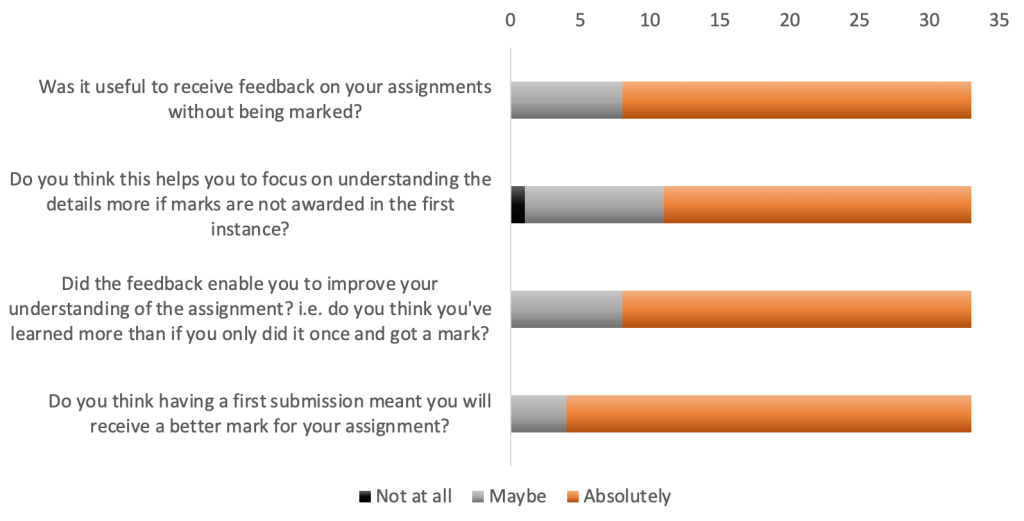I am a fan of formative assessment. It allows students the freedom to be wrong and provides an opportunity to learn unencumbered by evaluation. That same freedom, I believe, also encourages greater exploration, contributing to deeper, broader knowledge gain. If we can get great learning outcomes from formative activities, why shouldn’t we strive for the same in our formally assessed content?
I have embarked on a new journey in my teaching to find out how ‘not grading’ helps my students learn. Last year, I refused to grade students’ assignments until the end of the semester and instead provided the opportunity for students to obtain feedback and direction on their assignments during the semester. But why do we grade – and what happens when we don’t?
The problems with grading
We found that receiving a grade, as opposed to written comments alone, was associated with increased student ratings on distressed, upset, scared, hostile, ashamed, nervous, and afraid, all negative emotions. Additionally, we saw a decrease in pride when grades were given compared to written comments
Lipnevich, et al., 2021. Should I grade or should I comment: Links among feedback, emotions, and performance. Learning and Individual Differences, 89, p.102020.
Again and again, research tells us that grades don’t provide motivation or generate incentive to learn (Brookhart, 2017). Grades can encourage competitiveness and suppress creativity (Butler & Nisen, 1986); they can enhance anxiety and increase challenge avoidance behaviour (Chamberlin et al., 2018).
Grades can be terrible markers of learning and don’t provide useful feedback along the way (Schinske & Tanner, 2014). When we grade, we’re measuring output, but with little focus on the learning process; we’re valuing extrinsic rather than intrinsic motivation.
The benefits of de-grading
When you take grades out of the picture, the focus is on feedback. Formative approaches like narrative evaluations can support basic psychological needs and enhance intrinsic motivation by providing actionable feedback, promoting trust between instructors and students and cooperation amongst students (Chamberlain et al., 2018).
Without the pressure or penalty of judgement, ‘risk’ is reduced and there is space for creativity, learning and improvement. The benefits extend beyond the subject, too, as students can learn to use knowledge and apply it in multiple contexts, improving future performance (Keupper-Tetzel & Gardner, 2021).
How do students respond?
In Marine Algae and Productivity, a core subject in the Bachelor of Marine Biology and Climate Change, there are three assessments: a Data Journal (30%), an Experimental Design (30%), and a Viva Voce (40%). For the first two assessments, I invited students to submit an initial draft for detailed feedback before the final submission, which would be graded.
The ‘no stakes’ early submission gave students the opportunity to engage more with the assignment, address the feedback and feel as though they’d learned from the activity. By removing grades, students were more willing to take risks with their analyses and interpretations. This freedom to be creative, without risk of penalty, meant that students explored their data and design more extensively.
From my point of view, de-grading assessments was fantastic. I was able to concentrate on feedback that would advance the students’ understanding and learning experience without being tied to any judgement or need for quantitative evaluation. I was also pleasantly surprised by the grade distribution, which confirmed a high proportion of students achieving strong grades for their assignments.
But I was curious to learn how the students felt about delayed grading. The student feedback on this process was mostly positive, with 76% of students strongly agreeing that delayed grading improved their understanding of the assignment and 88% of students strongly agreeing that through this method their marks were improved (Figure 1).

Where to next?
Given the success of last years ‘de-grading’, I’m encouraged that not providing grades is a positive step towards improving student learning, encouraging engagement and supporting student wellbeing. My challenge now is to collect more data to quantitatively validate these observed benefits and share the findings with my colleagues, with the hope that their students can enjoy the freedom and excitement of learning in their subjects, too.
Further reading
- Brookhart, S.M. (2017). How to give effective feedback to your students. ASCD.
- Butler, R., & Nisan, M. (1986). Effects of no feedback, task-related comments, and grades on intrinsic motivation and performance. J Educ Psychol 78, 210.
- Chamberlin, K., Yasué, M., & Chiang, I.-C. A. (2018). The impact of grades on student motivation. Active Learning in Higher Education, 0(0). https://doi.org/10.1177/1469787418819728
- Lipnevich, A.A., Murano, D., Krannich, M. and Goetz, T. (2021). Should I grade or should I comment: Links among feedback, emotions, and performance. Learning and Individual Differences, 89, p.102020.
- Kuepper-Tetzel. C.E. and Gardner, P.L. (2021). Effects of temporary mark withholding on academic performance. Psychology Learning and Teaching. 20:404-419.
- Schinske, J. and Tanner, K. (2014). Teaching more by grading less (or differently). CBE—Life Sciences Education. 13: 159–166.
Feature image by Katherina Petrou.
